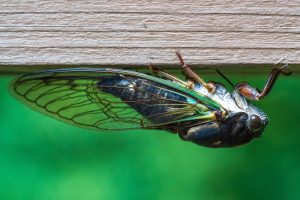
What is a Periodical Cicada?
Cicadas (pronounced “suh-kay-duhs”) are flying, plant-sucking insects of the Order Hemiptera. Many people know periodical cicadas by the name “17-year locusts” or “13-year locusts,” but they are not true locusts, which are a type of grasshopper. Adult cicadas tend to be large (most are 1″ – 2″ long), with prominent wide-set eyes, short antennae, and clear wings held roof-like over the abdomen. Cicadas are probably best known for their loud songs that male cicadas make during their courting and mating ritual. Most cicada species can be found every year because the population is not developmentally synchronized; these are often called “annual” cicada species. In contrast, the cicadas in a periodical cicada population are synchronized so that almost all of them mature into adults in the same year. The fact that periodical cicadas remain locked together in time is made even more amazing by their extremely long life cycles of 13 or 17 years. Periodical cicadas are found in eastern North America and belong to the genus Magicicada and their life cycles are so synchronized that they are nearly absent as adults in the 12 or 16 years between emergences. When they do emerge after their long juvenile periods, they do so in huge numbers and form swarms that are often visible for miles.
What Causes the Cicadas to Swarm?
The life cycle of each individual in the brood is synchronized, but each brood is on its own 13 or 17-year cycle. Cicadas nymphs develop underground and suck juices from plant roots. After 13 or 17 years below ground, mature nymphs may build mud tubes that project three to five inches above the soil to escape wet soil. These tubes are often mistaken for the tubes that crayfish build. The nymphs emerge from the soil at night and climb onto nearby vegetation or any vertical surface. The nymphs molt into winged adults and shed their outer skins which are often found attached to tree trunks and twigs. The emergence is often tightly synchronized, with most nymphs appearing within a few nights. Adult cicadas live for only two to four weeks. During this short time, they feed relatively little. Male cicadas sing by vibrating membranes on the underside of the first abdominal segment. Male courtship songs attract females for mating. Female cicadas are silent.
Will There be a Cicada Swarm in my Area?
Periodical cicada populations occur in groups that are identified as broods and are numbered by Roman numerals I through XXIII. Each brood appears on its own 13 or 17-year schedule. Brood X will make its 17-year appearance in May of 2021, depending on the weather, and will be present all over the midwest, southeast, and east coast. Although it may be a different cicada group that appears in your area, if you live in a region known for brood cicada placement, be sure to keep an eye, or ear out for them.
How Bad Will it Be?
The density of cicadas during their 13 or 17 year period is enormous and can exceed 1 million per acre. The Brood X swarm of 1987 has been described as “biblical in proportion” by residents of Cincinnati. In the hardest-hit areas, cicadas darken the skies. The adult phase of their long life cycle is short but intense. The swarm may reach alarming proportions for several consecutive days.
How Does a Cicada Swarm Impact my Cooling Tower?
Cooling towers, air washers, evaporative condensers, and air-handling units in brood-infested areas, especially ones that are near naturally forested areas or are surrounded by trees are vulnerable. Huge numbers of cicadas can be sucked into the air intake. The threats from thousands of cicadas suddenly entering your cooling tower include clogged cooling tower fill which can reduce airflow, clogged strainers which will reduce the flow rate and impact chiller efficiency, solenoid blowdown valves clogged in the open position resulting in increased make-up water and sewer costs, increased organic debris load which results in elevated bacteria levels including Legionella, fouled heat exchangers which reduce the flow rate and heat transfer efficiency, and increased system downtime, lost productivity, missed shipments, and increased maintenance costs. Cooling tower operators in Louisville report cleaning their tower intake strainers every hour during June 1987.
Is There Anything I Can do to Prevent this?
You must weigh the short-term nature of the swarm against the cost of preventative measures. Intake filter media can be stretched across cooling tower intakes to prevent cicadas from reach the water, but the filter media is costly and must be changed or rotated regularly during the swarm to ensure adequate airflow through the tower. Be aware that window screen, roll filter media, or mesh purchased from a hardware store to cover intake openings is not designed to allow proper high-volume airflow and can drastically increase static pressure and energy costs and impede cooling efficiency.
In Conclusion, do not let cicadas take your cooling tower out of action. Chardon can you help maintain efficiency in your system.
Contact us today for a free quote!

Matt Welsh
Matt Welsh is the Vice President and Water Consultant at Chardon Labs. He helps consult a wide range of customers utilizing various methods of water treatment, from chemical to chemical-free approaches, large and small applications, and across a wide range of geographical influences. With 20 years of water treatment experience, including a wide range of troubleshooting and service in potable water and non-potable HVAC and industrial applications, he is an expert in water treatment chemistry for cooling towers, boilers, and closed-loop systems.
